Weighted blankets are great to use for warmth, but do you know how to make a weighted blanket without pellets?

Simple—just use alternative fabrics like wool or denim or alternative fillers like glass microbeads or rice and beans.
If you are not sure how to get your project started, below are tips to help you make your weighted blanket without using plastic pellets for a more eco-friendly alternative.
Step-By-Step Guide On How To Make A Weighted Blanket Without Pellets
Step #1. Choose your materials
You will need two fabrics of the same size to make your blanket. You can use a lightweight fabric such as cotton or a warmer fabric like flannel or fleece.
Ensure that you have enough fabric to make the blanket your desired dimensions plus an added inch to the length and width for seam allowance.
Step #2. Calculate the weight of your blanket
Your blanket weight should be ten percent of your ideal weight as an adult or a tenth of the current weight of a child.
It is important not to make the blanket too heavy because it could either weigh you down, make it difficult for you to move, or even prevent you from breathing properly.
Step #3. Secure your fabric pieces together
Measure your fabric to the same size.
Align and pin three sides of both pieces with the printed sides facing each other, and sew half an inch from each of the pinned sides.
Begin sewing at a corner and sew all around the pinned edges.
Make sure to leave one of the edges open to put the fillers later on, then turn the blanket right side out and push out the fabric around the inner corners as necessary.
Step #4. Measure and mark the blanket sections
Make a mark every ten centimeters on the open edge of the blanket and one adjacent edge.
Use chalk to make these marks. Create a grid and divide the total weight by the number of squares on your grid.
This is so that your blanket will evenly distribute the weight.
Step #5. Filling and sewing the blanket
Sew straight stitches down the lines you have marked along the open edge of the blanket. This is where you will be pouring down your blanket fillers later on.
Measure the amount of filling you need for each square and pour down the number of pellets for each of the columns. Sew across the columns to secure your squares.
Continue filling the columns and sewing across the blanket until you distribute the required amount of filling to all the squares, and finish the edge of the blanket with a folded seam.
Step #6. Add borders for comfort
If you wish to add borders to the blanket, you can do so. Choose a luxurious or soft fabric like satin.
Fold over each of the fabric strips and iron along the folded edges to make a crease.
Wrap a strip around the edge of the blanket, pin, and sew. Do this for all four edges.
Poly Pellet Alternatives
While poly pellets are commonly used as fillers for weighted blankets, the material is not very eco-friendly. Here are some poly pellet alternatives to use instead.
-
Micro glass beads
Micro glass beads resemble white sand or salt but are perfectly smooth.
They are environmentally friendly alternatives to poly pellets and are hypoallergenic, making the material machine-washable and dryer safe.
-
Steel shot beads
Steel shot beads are larger and heavier than glass beads, making them less likely to leak through the stitches of the blanket.
They are also extremely durable and allergen-free. Like micro glass beads, they are machine washable.
-
Sand
Sand can also be used as fillers for weighted blankets. However, most sands are only semi-organic, and craft sand tends to clump when it gets wet.
It also does not disperse as evenly throughout the blanket and is likely to leak through the stitching.
If sand is used as filler, make sure to reinforce stitches and consider sending them to the dry cleaners for periodic cleaning.
-
Rice and beans
Some companies use dried food such as uncooked rice, beans, corn barley, or pasta as fillers for weighted blankets.
However, food will likely deteriorate, making them less durable material. They can also grow mold and fungus or attract insects.
Most of these foods also tend to expand when they absorb water, and they alter the weight and shape of the blanket.
-
Pebbles
Another option is to use pebbles and rocks. However, since they are not always the same size, it can be difficult to distribute their weight in the blanket evenly.
If you prefer to add stones to your weighted blanket, opt for smaller ones similar in size.
If you’re using river stones or pebbles, make sure to dry them out completely before sewing them into the blanket lining.
Conclusion
Weighted blankets are very comfortable. They feel like hugs, keep you warm, and alleviates anxiety. They are also easy to make.
If you want to know how to make a weighted blanket without pellets, your best option is to use alternatives like glass microbeads.
You could also go more organic and use dried food like rice and beans, but you have to put more care into your blanket to avoid molds, fungi, and insects.
